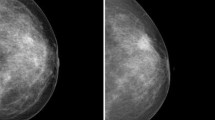Abstract
Clinical examination is a simple method to detect breast lumps and their nature as it is inexpensive and non-invasive and if found to be accurate, might be of great value as a diagnostic tool. The aim of this study was to evaluate the accuracy of clinical examination and its contribution towards the diagnosis of a palpable breast lump. The study was record based and conducted at a University Medical College Hospital and a tertiary referral centre of South India. Patient files of those women who presented with a breast lump between January to December 2011 were studied. A total of 120 patients were obtained following necessary exclusions. The accuracy of clinical assessment at an outpatient facility was determined by comparing the physician’s diagnosis with the final histopathological diagnosis. The inter-observer agreement (kappa) for diagnosing a breast lump was 81 % (95 % Confidence Interval = 71 % to 92 %) indicating a good agreement between clinical and pathological diagnoses. McNemar test also indicated a high degree of concordance between the two diagnoses (4.17 % discordance). Sensitivity, specificity, positive and negative predictive values of clinical breast examination in comparison to histopathology were 95, 88, 87, and 95 % respectively, with an overall accuracy of 90.8 %. 11 lumps were wrongly diagnosed at the time of clinical examination. Clinical examination of breast lumps was found to have a high sensitivity (94.5 %) and specificity (87.7 %) and can be used as the diagnostic tool to identify the nature of the lump, however, its value in diagnosing breast malignancy remains contributory due to the possibility that malignant lumps could be overlooked and present as advanced cancer at a later stage. Histopathology is recommended in all cases unless clinical examination is supported with strong evidence of benignity based on repeated breast imaging via ultrasound or mammogram (>35 yrs).
Similar content being viewed by others
References
Curado MP (2011) Breast cancer in the world: incidence and mortality. Salud Publ Mex 53:372–384
Meads C, Ahmed I, Riley RD (2011) A systematic review of breast cancer incidence risk prediction models with meta-analysis of their performance. Breast Cancer Res Treat Oct 22 [Epub ahead of print]
Nederend J, Duijm LE, Voogd AC, Groenewoud JH, Jansen FH, Louwman MW (2012) Trends in incidence and detection of advanced breast cancer at biennial screening mammography in The Netherlands: a population based study. Breast Cancer Res 14:R10
Prasad SN, Houserkova D (2007) A comparison of mammography and ultrasonography in the evaluation of breast masses. Biomed Pap Med Fac Univ Palacky Olomouc Czech Repub 151:315–322
Hampton T (2012) Breast cancer symposium highlights risk, recurrence, and research trials. JAMA 307:348–350
Magarey CJ (1976) Detection and diagnosis of early breast cancer. Med J Aust 2:834–837
Magarey CJ, Watson WJ (1976) The outpatient diagnosis of breast lumps. 46:344-349
Thomas JM, Fitzharris BM, Redding WH et al (1978) Clinical examination, xeromammography, and fine-needle aspiration cytology in diagnosis of breast tumours. Br Med J 2:1139–1141
Crone P, Hertz J, Nilsson T et al (1984) The predictive value of three diagnostic procedures in the evaluation of palpable breast tumours. Ann Chir Gynaecol 7:273–276
Di Pietro S, Fariselli G, Bandieramonte G et al (1987) Diagnostic efficacy of the clinical-radiological-cytological triad in solid breast lumps: results of a second prospective study on 631 patients. Eur J Surg Oncol 13:335–340
Martelli G, Pilotti S, Coopmans de Yoldi G et al (1990) Diagnostic efficacy of physical examination, mammography, fine needle aspiration cytology (triple-test) in solid breast lumps: an analysis of 1708 consecutive cases. Tumori 76:476–479
Ghimire B, Khan MI, Bibhusal T, Singh Y, Sayami P (2008) Accuracy of triple test score in the diagnosis of palpable breast lump. JNMA J Nepal Med Assoc 47:189–192
Reeves MJ, Osuch JR, Pathak DR (2003) Development of a clinical decision rule for triage of women with palpable breast masses. Clin Epidemiol 25:636–645
Barton MB, Harris R, Fletcher SW (1999) Does this patient have breast cancer? The screening clinical breast examination: Should it be done? How? JAMA 282:1270–1280
Conflict of interest
Nil
Sources of funding
Nil
Author information
Authors and Affiliations
Corresponding author
Rights and permissions
About this article
Cite this article
Ravi, C., Rodrigues, G. Accuracy of Clinical Examination of Breast Lumps in Detecting Malignancy: A Retrospective Study. Indian J Surg Oncol 3, 154–157 (2012). https://doi.org/10.1007/s13193-012-0151-5
Received:
Accepted:
Published:
Issue Date:
DOI: https://doi.org/10.1007/s13193-012-0151-5




